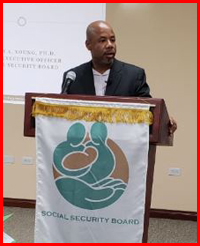 The Social Security Board has announced that it has completed its 2 year long round of consultations with labor organizations, employers and other stakeholders and they have announced changes to the laws, payment schedules and benefits to employees.
The Social Security Board has announced that it has completed its 2 year long round of consultations with labor organizations, employers and other stakeholders and they have announced changes to the laws, payment schedules and benefits to employees.
Chief Executive Officer, Colin Young at the Board explained on Tuesday June 11 that the process has been an all inclusive one that saw at least 100 consultations across the country. Young pointed out that at the rate at which the SSB is paying out pensions it would have been in trouble by the end of this year. He said that had it continued as it was, some 1.6 million dollars would have had to be sourced from deposits or other assets that the board has. Simply put, the payouts would have been more than the contributions by 1.6 million dollars. Next year that would have ballooned to 13 million and the following to 26 million in liquidation of assets. That simply was untenable and the decision was made to increase contributions.
It has not been since 2003 that the contribution schedule has been frozen yet pensions have had a 5% increase to accommodate cost of living. Young says that persons are retiring at a rate of 10 to 13 percent per year amounting to between 1000 to 1300 persons per year. This benefit is the one that requires the single largest amount of money. Young gave a simple real-life example where a person who contributes to the fund in 10 years $4,959 at the end of 10 year of retirement that same person would have collected $49,920.
With the new schedule there are some adjustments from the lowest end of contributions to the highest end and an additional 5 tranches of insurable income will be added. On the lowest end, persons earning under 70 dollars, with 55 dollars being insured, they are paying 83 cents per week with the employer paying $3.57 for a total of $4.40. Under the new schedule, that will become effective on July 1, 2019. The same employee will be asked to pay 88 cents while the employer will pay $3.80.
Currently only up to $320 per week of income can be insured. That will change between July 1, 2019 and January 5, 2020 when employees’ insurable income will increase in three tranches. The first will be for employees earning between $340 to $379.99 per week the second for those earning from $380 to $419.99 and the third for those earning $420 and more. Those earning in the $340 bracket will be asked to pay weekly $11.89 while their employers will pay $18.71 for a total contribution of $30.60 per week. On the highest end, employees will pay $15.68 per week, while employers will pay $21.72 for a total of $37.40. Insurable income in this bracket will be $440. On an individual becoming pensionable at this range, they will collect benefits of $264 weekly. As it currently stands, the most a pensioner can collect is $192 per week.
On January 6, 2020 and going up to January 3, 2021 a new tranche will be added for persons earning $460 and over. Their payment will be $18.78, while the employer will pay $24.42. On retirement the pensioner will receive $288.
A final tranche will be added on January 4, 2021 with a maximum of $520 being insurable. That will see employees paying $23.40 and employers $28.60 for a total of $52 weekly. On retirement pensioners will receive $312 per week.
According to Young, this bracket of persons that are being added is representative of about 55 percent of those contributing into the fund. Employees would have to have paid for at least 3 years at the new rate before they would be eligible to the new pension payout.
While the pensions are the largest cost to the SSB, Young says that all other short term benefits will also increase.
The new adjustments will breathe some life into the SSB but by 2024, the board is likely to find itself in the same position as it is at right now. The CEO says that within a short space of time discussions need to be had to have some triggering mechanism during which rates will automatically be adjusted without having to go through the involved process that the board underwent over the past two years.
Currently, aside from the rate changes, legislation is also being amended to redefine what it means to be a child where unmarried persons below the age of 18 and up 21 and still receiving an education will now be classed as such. To qualify for invalidity, a person now needs to be sick for 26 consecutive weeks as opposed to 13 weeks as it was before. Time allotted to make sickness and injury claims have now been extended from 4 to 14 days.
There are other amendments which include the persons who are now eligible to hold a social security card among others.




